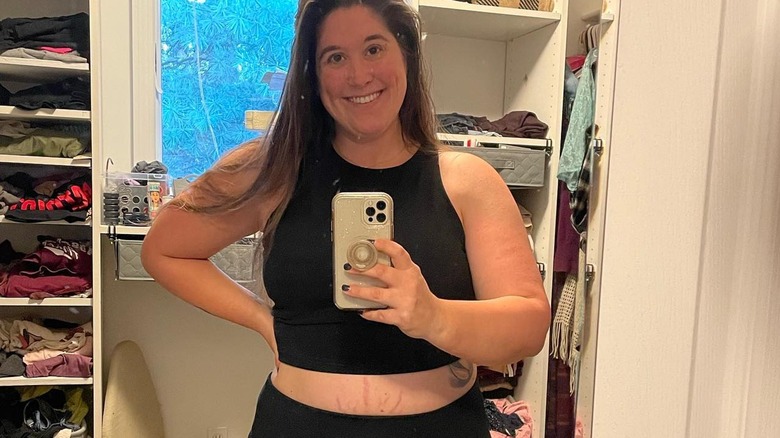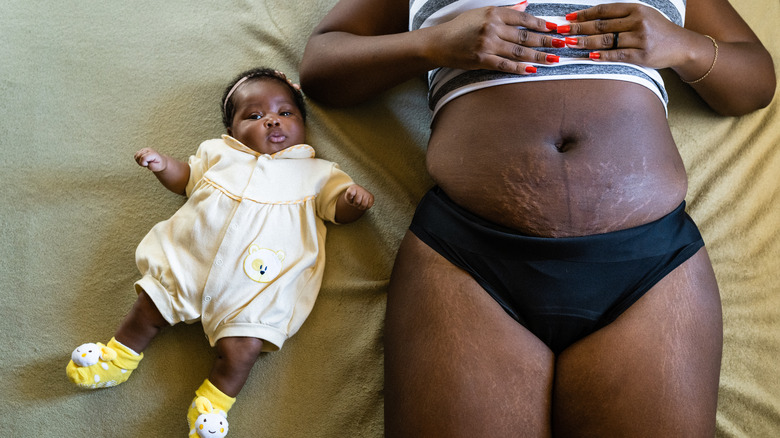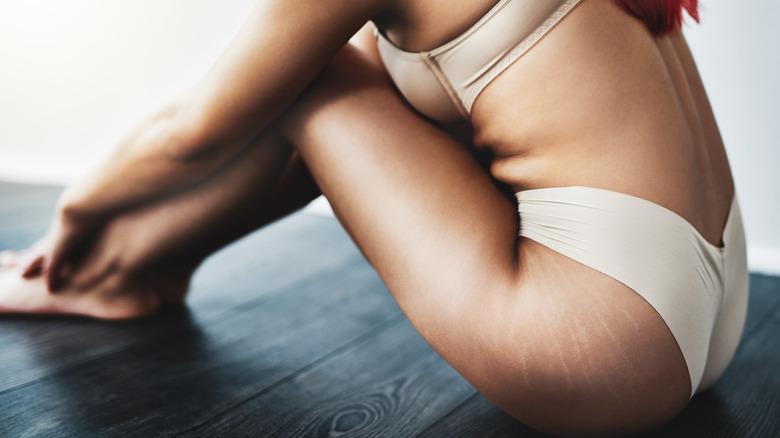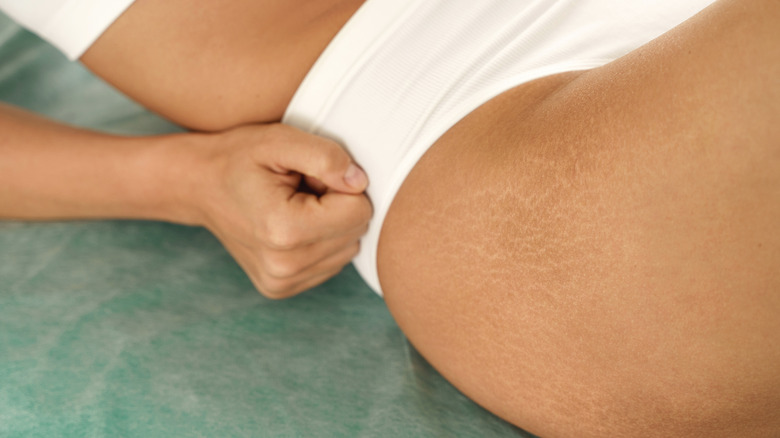What Really Causes Stretch Marks (& How Can You Stop Caring So Much)?
Along with pimples, cellulite, and eczema, stretch marks are another unavoidable bodily creation that some of us are just marked for. Those bumpy red or brown scars are officially known as "striae distensae," according to Right as Rain by UW Medicine, and can happen to anyone. They're caused by the strain on the skin that occurs during a period of rapid weight gain or growth.
Unfortunately for those who are yet to fall in love with their stretch marks, these marks are a form of permanent scarring. While you can't get rid of them, they do tend to become less obvious with time, fading from red or brown to white or skin color.
There are things you can do to reduce their appearance, but you shouldn't feel any pressure to do so. Seeing as your stretch marks are, for the most part, here to stay, it's worth learning how to make your peace with them. You may not ever learn to love these scars, but by changing your mindset and self-talk, you can get to a point where you stop caring so much. Because ultimately, most stretch marks are less than a few inches long; they don't really have the power to ruin your life unless you let them.
The scientific reason for stretch marks
It's possible to grow or gain weight without getting stretch marks, but it's the pressure of super quick growth that leads to scarring. As Right as Rain explains, the skin struggles to expand at the rate it needs to in order to keep up with the body growth, whether that's in height or weight. As a result, the collagen and elastin present in the skin is damaged, which leads to the visible marks on the surface of the skin.
Speaking to the outlet, University of Washington Medical Center-Roosevelt dermatologist Dr. Michi Shinohara shared that the initial redness of the stretch marks occurs because of "the body's attempt at healing the wound."
Stretch marks are most commonly associated with pregnancy, but they can also appear on the skin of children going through puberty or body-builders and athletes experiencing extreme muscle growth. People with certain medical conditions that lead to rapid weight gain can also get stretch marks. Around 50 to 90% of women have them, but men do get them, too — the notion that men don't get stretch marks is a myth (via WebMD). So the major reason not to care about their existence is because they are totally normal. Statistically speaking, most of the women you come across will have them, too.
Get to a point of neutrality
Ideally, it would be great to come to love your stretch marks the way you love other parts of your body. Self-love sets the standard for how other people treat you and comes with an array of mental health benefits, and part of that is loving and respecting your body from head to toe. But truthfully, love can feel like an impossible target when you feel terrible about something on your body, like your stretch marks.
It's totally understandable that there's a universal struggle to develop positive feelings towards stretch marks and other "imperfections" when society conditions us to be so hard on ourselves. If you're judging yourself against conventional beauty standards and you have a deep-set dislike or even hatred toward that part of yourself, reaching for body-positivity might be too much to begin with. That's okay. Aim for neutrality instead.
Rather than trying to love your stretch marks, commit to no longer saying negative things about them. You don't have to find them beautiful, but stop calling them ugly. Remind yourself that they're normal, and in many cases, they're actually a consequence of your body doing something amazing, like growing a baby. Watch out for any hurtful self-talk surrounding your stretch marks and silence that inner-critic, even if you can't transform those negative statements to positive ones just yet.
Find the right role models
Role models can be massively helpful in learning to reject unrealistic traditional beauty standards. Really, would anybody have dared to rock high-low sweats in public if Kim Kardashian hadn't made it cool? Figures that we look up to have so much influence over the way we feel about ourselves, so find role models that flaunt their stretch marks. Mute influencers who use filters to portray perfection and instead follow people like model Ashely Graham, who captioned one 2021 Instagram post, "Justin says my stretch marks look like the tree of life."
Actor and activist Jameela Jamil also shared her stretchmarks on social media, along with how she interprets the scars on her body: "I have stretch marks all over my body and I hereby rename them all Babe Marks," Jamil wrote in the caption. "They are a sign my body dared to take up extra space in a society that demands our eternal thinness. They are my badge of honour for resisting society's weaponizing of the female form."
There are plenty of celebrities paving the way to the global acceptance of stretch marks, but there are lots of ordinary folks joining in the effort, too. Search for the hashtag #stretchmarksarebeautiful on Instagram to find pictures and stories from regular people embracing their own.
Flaunt them when you're ready
Flaunting your stretch marks can be a powerful way to embrace them. If you're determined to hide them from the world, then showing them off rips the Band-Aid off and shows you that you don't have anything to be afraid of. Exposing them either in real life or on social media can be empowering, and can even inspire others to stop being embarrassed about their own stretch marks.
That said, you definitely don't need to show them off if you're not comfortable doing so. When you really struggle with accepting your stretch marks, the thought of letting people see them may be overwhelming. It's better to work through those feelings without the noise that can come from other people. In all likelihood, you'll probably find that people are positive about your stretch marks and commend you for taking a step to normalize them, but it's also possible that you'll come across cruel or mean responses. Haters gonna hate, unfortunately.
It's absolutely fine if you want to wait until you get to a point of neutrality or positivity before showing them off, if you feel inclined to. But if you do feel ready, flaunting them can remind yourself and the world of the underlying truth here: They're just stretch marks. Who really cares?




